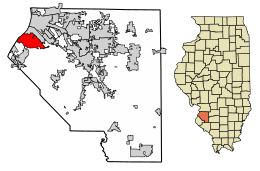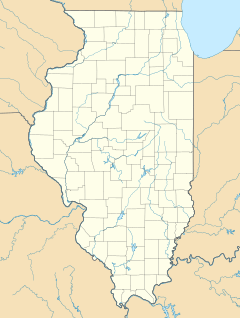Cahokia, Illinois facts for kids
Quick facts for kids
Cahokia
|
|
|---|---|

Location of Cahokia in St. Clair County, Illinois.
|
|
| Country | |
| State | |
| County | St. Clair |
| Area | |
| • Total | 10.31 sq mi (26.70 km2) |
| • Land | 9.75 sq mi (25.26 km2) |
| • Water | 0.56 sq mi (1.44 km2) |
| Elevation | 407 ft (124 m) |
| Population
(2020)
|
|
| • Total | 12,096 |
| • Density | 1,423.15/sq mi (549.46/km2) |
| Time zone | UTC-6 (CST) |
| • Summer (DST) | UTC-5 (CDT) |
| Area code(s) | 618 |
| FIPS code | 17-10370 |
| GNIS feature ID | 426287 |
| Wikimedia Commons | Cahokia, Illinois |
Cahokia is a settlement and former village in St. Clair County, Illinois, United States, founded as a colonial French mission in 1689. Located on the east side of the Mississippi River in the Greater St. Louis metropolitan area, as of the 2010 census, 15,241 people lived in the village. On May 6, 2021, the village was incorporated into the new city of Cahokia Heights.
The name refers to one of the clans of the historic Illiniwek confederacy, who met early French explorers to the region. Early European settlers named the nearby (and long-abandoned) Cahokia Mounds in present-day Madison County after the Illini clan. But the UNESCO World Heritage Site and State Historic Park was developed by the Mississippian culture, active here from AD 900 to AD 1500 some connection to the clan is possible but unknown. The area was part of an extensive urban complex, the largest of the far flung Mississippian culture territory through the Mississippi and Ohio river valleys.
French Canadian colonists founded Cahokia village in 1696 as a Catholic mission. The historic Church of the Holy Family is the oldest continually active Catholic parish in the United States, as well as the oldest church west of the Allegheny Mountains. Other significant colonial and Federal-period buildings listed on the National Register of Historic Places include the Cahokia Courthouse (c. 1740, in the French Colonial style); and the Jarrot Mansion (c. 1810).
Contents
History
While the Europeans also named the Cahokia Mounds site to the north after the Illini group, archeologists have determined that the earthwork mounds complex was built by the Mississippian culture, an earlier, potentially unrelated indigenous people. The city site reached its peak in the 13th century and was abandoned centuries before European contact. The Cahokia Native Americans did not coalesce as a group and live in the Illinois area until closer to the time of French contact.

The European association with Cahokia began over 300 years ago, with Father Pinet’s mission in late 1696 to convert the Cahokian and Tamaroa Indians to Christianity. Father Pinet and the Seminary of Foreign Missions of Quebec built a log church. It is dedicated to the Holy Family. During the next 100 years, Cahokia became one of the largest French colonial towns in the Illinois Country.
Cahokia had become the center of a large area for trading Indian goods and furs. The village had about 3,000 inhabitants and a thriving business district. The nearby town of Kaskaskia on the Mississippi became the region’s leading shipping port, and Fort de Chartres became a military and governmental command center. The 50-mile (80 km) area of land between the two cities was cultivated by farming settlers, known as habitants, whose main crop was wheat. As the area expanded, the relationship between the settlers and the Indians continued to be peaceful. Settlers were mostly Canadien migrants whose families had been in North America for a while.
In the following years, Cahokia suffered, mainly from the French loss in the French and Indian War in 1763. Defeated by Great Britain in what was an extension of the Seven Years' War in Europe, the French were forced to cede large parts of the Illinois Country to the victors. Many Cahokians fled in fear of the British, or because they wanted to live in a Catholic province, to Louisiana, where they founded new Canadien villages on the west of the Mississippi River, such as St. Louis, and Ste. Genevieve, Missouri.
The Odawa leader Pontiac was assassinated by other Indians in or near Cahokia on April 20, 1769.
In 1778, during the American Revolutionary War, George Rogers Clark set up a court in Cahokia, making Cahokia an independent city state even though it was part of the Province of Quebec. Cahokia officially became part of the United States by the Treaty of Paris in 1783. Soon after that, the 105 Cahokia "heads of household" pledged loyalty to the Continental Congress of the United States.
Later, Cahokia was named the county seat of St. Clair County. The Cahokia Courthouse acted as a United States territorial courthouse and a major political center for the next 24 years. When in 1801 St. Clair County was enlarged, Henry Harrison named the Cahokia Courthouse the legal and governmental center of a sizeable area extending to the Canada–US border. By 1814, other counties and territories had been organized, and St. Clair County was defined as its current size. The county seat was moved to Belleville, Illinois.
Geography
Cahokia is located at 38°33′43″N 90°10′22″W / 38.561901°N 90.172878°W.
According to the 2010 census, Cahokia has a total area of 9.9 square miles (25.64 km2), of which 9.4 square miles (24.35 km2) (or 94.95%) is land and 0.5 square miles (1.29 km2) (or 5.05%) is water.
Demographics
| Historical population | |||
|---|---|---|---|
| Census | Pop. | %± | |
| 1880 | 211 | — | |
| 1930 | 286 | — | |
| 1940 | 465 | 62.6% | |
| 1950 | 794 | 70.8% | |
| 1960 | 15,829 | 1,893.6% | |
| 1970 | 20,649 | 30.5% | |
| 1980 | 18,904 | −8.5% | |
| 1990 | 17,550 | −7.2% | |
| 2000 | 16,391 | −6.6% | |
| 2010 | 15,241 | −7.0% | |
| 2020 | 12,096 | −20.6% | |
| U.S. Decennial Census | |||
2020 census
| Race / Ethnicity (NH = Non-Hispanic) | Pop 2010 | Pop 2020 | % 2010 | % 2020 |
|---|---|---|---|---|
| White alone (NH) | 5,126 | 2,689 | 33.63% | 22.23% |
| Black or African American alone (NH) | 9,455 | 8,554 | 62.04% | 70.72% |
| Native American or Alaska Native alone (NH) | 30 | 43 | 0.20% | 0.36% |
| Asian alone (NH) | 29 | 10 | 0.19% | 0.08% |
| Pacific Islander alone (NH) | 2 | 6 | 0.01% | 0.05% |
| Some Other Race alone (NH) | 29 | 52 | 0.19% | 0.43% |
| Mixed Race/Multi-Racial (NH) | 272 | 457 | 1.78% | 3.78% |
| Hispanic or Latino (any race) | 298 | 285 | 1.96% | 2.36% |
| Total | 15,241 | 12,096 | 100.00% | 100.00% |
Transportation
Cahokia is home to the St. Louis Downtown Airport, a general aviation facility.
Metro operates the #2 bus route to East St. Louis, Illinois, where connections can be made to the MetroLink light rail to St. Louis.
Education
- Cahokia Unit School District 187 operates public schools.
Notable people
- 18th-century settler Marie Josephte L'Archevêque, her daughter Marie Joseph La Marche (Mme. Le Comte), and granddaughter Marie Josette Languedoc from Cohakia inspired what Governor John Reynolds said was the "truthful" telling of Madam La Compt in Pioneer History of Illinois.
- Terron Armstead - NFL player
- Well Hungarians – country and rock band
- Michael B. Whit - country singer-song writer
See also
 In Spanish: Cahokia (Illinois) para niños
In Spanish: Cahokia (Illinois) para niños



